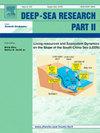Exploring sea ice transport dynamics at the eastern gate of the Ross Sea
IF 3
3区 地球科学
Q2 OCEANOGRAPHY
Deep-sea Research Part Ii-topical Studies in Oceanography
Pub Date : 2024-10-11
DOI:10.1016/j.dsr2.2024.105428
引用次数: 0
Abstract
As Antarctic sea ice extent continues to reach record lows, significant efforts have been directed towards understanding the underlying processes and their regional differences within the Southern Ocean. Here, we explore the dynamics of zonal sea ice transport at the eastern gate of the Ross Sea from 1988 to 2023 using GIOMAS-model and ERA5-reanalysis data. Our analysis reveals a modest overall increase in eastward sea ice transport (3.721 ± 0.672 km³/month per decade), with diverging trends in the coastal and open ocean zones. Driven by easterly winds and the Antarctic Slope Current, the predominant westward transport in the coastal region experienced a significant rise during the early 2000s, followed by a steep decline post-2011. Conversely, driven by the Antarctic Circumpolar Current, the strong open-ocean transport exhibited a moderate increase towards the Amundsen Sea until the late 1990s, which was interrupted by a reversal in 2007. The variability of zonal sea ice transport and its underlying conditions (sea ice concentration, thickness, and zonal drift) revealed considerable shifts throughout the different decades and on seasonal scales. During austral winter, approximately half of the zonal sea ice transport variability seems to be driven by large-scale teleconnections, including the Southern Annular Mode, Southern Oscillation Index, Amundsen Sea Low and the Zonal Wave 3 with considerable impacts on the wind stress field. Whereas during summer, the Southern Oscillation Index emerges as the dominant driver, exhibiting a significant positive correlation (r=0.55, p<0.001) that reflects the influence of the El Niño-Southern Oscillation, while other teleconnections play minimal roles. Our study highlights the complex nature of sea ice transport through the eastern gate of the Ross Sea towards the Amundsen Seas, where contrasting climatic conditions are known to occur.
探索罗斯海东门的海冰迁移动力学
由于南极海冰面积持续创历史新低,人们一直在努力了解南大洋的基本过程及其区域差异。在此,我们利用 GIOMAS 模型和 ERA5 分析数据,探讨了 1988 年至 2023 年罗斯海东门海冰输送的动态变化。我们的分析表明,海冰向东输送总体上略有增加(每十年 3.721 ± 0.672 千米³/月),沿岸带和开阔洋带的趋势不同。在东风和南极斜坡洋流的驱动下,沿岸地区主要的西向传输量在 2000 年代初显著增加,2011 年后急剧下降。相反,在南极环极洋流的驱动下,强大的公海运移在 20 世纪 90 年代末之前一直呈现出向阿蒙森海的适度增长,2007 年的逆转中断了这一增长。带状海冰传输及其基本条件(海冰浓度、厚度和带状漂移)的变化显示,在不同的年代和季节尺度上都有相当大的变化。在澳大利亚冬季,约有一半的海冰输送带变化似乎是由大尺度遥联系驱动的,包括南环流模式、南方涛动指数、阿蒙森海低海平面和对风应力场有重大影响的带状波 3。而在夏季,南方涛动指数是主要的驱动因素,表现出显著的正相关性(r=0.55,p<0.001),反映了厄尔尼诺-南方涛动的影响,而其他远缘联系的作用微乎其微。我们的研究强调了海冰通过罗斯海东门向阿蒙森海迁移的复杂性,众所周知,在那里会出现截然不同的气候条件。
本文章由计算机程序翻译,如有差异,请以英文原文为准。
求助全文
约1分钟内获得全文
求助全文
来源期刊
CiteScore
6.40
自引率
16.70%
发文量
115
审稿时长
3 months
期刊介绍:
Deep-Sea Research Part II: Topical Studies in Oceanography publishes topical issues from the many international and interdisciplinary projects which are undertaken in oceanography. Besides these special issues from projects, the journal publishes collections of papers presented at conferences. The special issues regularly have electronic annexes of non-text material (numerical data, images, images, video, etc.) which are published with the special issues in ScienceDirect. Deep-Sea Research Part II was split off as a separate journal devoted to topical issues in 1993. Its companion journal Deep-Sea Research Part I: Oceanographic Research Papers, publishes the regular research papers in this area.

 求助内容:
求助内容: 应助结果提醒方式:
应助结果提醒方式:


